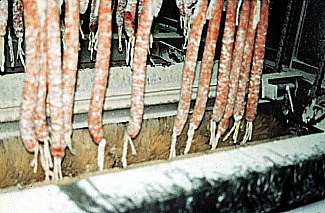Coating of cured meats: a rarely-known cause of hypersensitivity pneumonitis

The term hypersensitivity pneumonitis (HP) encompasses a group of lung diseases produced by inhalation of certain substances, mainly organic, which, in susceptible individuals, can trigger an inflammatory reaction at the level of the alveoli, bronchioles, and pulmonary interstitium. The clinical presentation is heterogeneous and, thus, HP may present as an acute, subacute, or chronic disease, depending, among other factors, on the intensity and frequency of exposure. Patients with acute or subacute HP usually respond to treatment, whereas those with chronic disease at the time of diagnosis often progress to irreversible lung destruction with fibrotic or emphysematous changes. Many unrecognized types of exposure may be at the origin of HP. The description of new causative exposures would increase the possibility of reaching an early diagnosis of these conditions.
Recently, our group have published five cases of HP due to inhalation of dry sausage dust at their workplace, a very little known type of occupational exposure causing HP. In Spain, workers in the dry pork sausage industry are known as chacineros, the name we propose for this disease.Very few cases of this condition have been previously reported. All patients described were actively working in the food industry, involved in the production of dry sausages. To improve the flavor of these products, the sausages are dipped in a bath containing molds, and then left to ferment and dry for 3 to 4 months in humidity- and temperature-controlled rooms. At the end of the process, the mold covering the product is removed by brushing, as we can see in the picture. In three of the patients that we describe, the exposure was massive, since their work involved cleaning the fungi covering the product by brushing. The fourth and fifth patients, who experienced a subacute disease course, worked as a secretary and supervisor in the respective companies implicated. Although there was environmental exposure in these cases, inhalation of the antigens was not as massive as in the other patients.
In conclusion, a work-related cause of HP is described in this study. Physicians should be aware of this association because in many countries such as ours, elaboration of raw food products derived from hogs is a widespread industry. Although Penicillium frequentans seems to be one of the main fungi involved in this cause of HP, a multifactorial origin cannot be ruled out, with other fungi such as Aspergillus fumigatus, Mucor mucedo, or Rhizopus nigricans being implicated.
References
"Chacinero's lung - hypersensitivity pneumonitis due to dry sausage dust". Morell F, Cruz MJ, Gómez FP, Rodriguez-Jerez F, Xaubet A, Muñoz X. Scand J Work Environ Health. 2011 Jul; 37(4):349-56.


